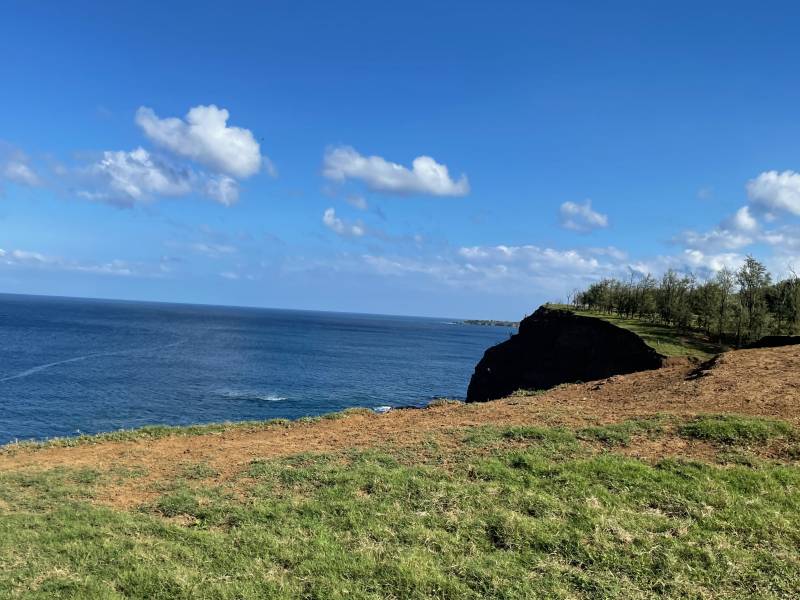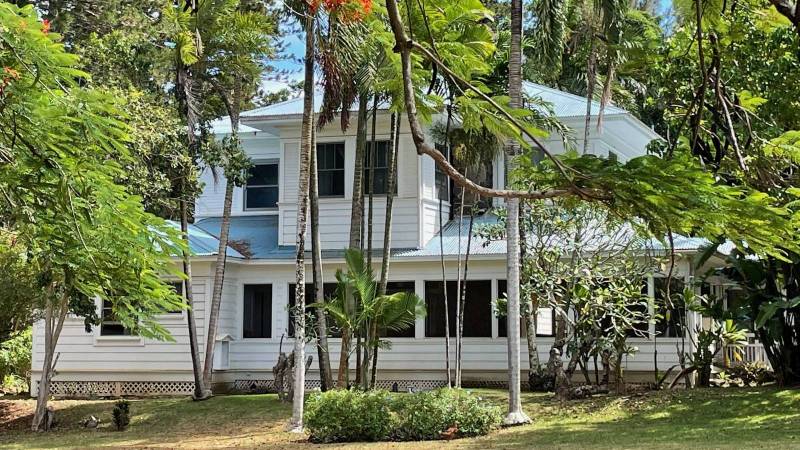I had multiple calls this past week referring to old blog posts with similar questions: what the caller could do on, or build on, or how they might use land zoned “Ag” or agricultural in Hawaiʻi. I can only share resources and never give answers regarding specific parcels, and always with a caveat that anything I say or they research today might change in 5 or 10 or 15 years.
But here are a few reference blog posts, links, and resources for answering questions about your plans for the ag-zoned property you bought or want to buy in Hawaiʻi. Some of this is specific to Hawaiʻi County – the Big Island – but much of it applies anywhere in the State.

Chicken tractor next to vegetable beds on my listing of 5 acres of Ag-zoned land with a small house on it near Hawi – MLS 669788
State Land Use Designations versus County Agricultural Zoning – When Special Restrictions and Permits Might Apply
As I have blogged previously, all land in Hawaiʻi is designated by the State into four categories: conservation, agricultural, rural and urban. The Hawaiʻi statutes then delegate land use planning decisions to the counties, with a few exceptions.
- Oceanfront areas are considered coastal management zones (CMZ), and have requirements for environmental assessment and another layer of permitting beyond regular County code, which affects everything from tree removal to setbacks for building structures. The biggest news there is that setbacks are being increased in light of the likely consequences of sea level rise associated with global warming.
- Agricultural parcels over 15 acres – land use decisions such as rezoning or subdivision have to be approved by the State not the County. Besides the inconvenience and expense for almost all owners in our rural areas where the zoning tends to be something like “Ag-2oa” on the Big Island, meaning minimum parcel sizes of 20 acres, this has become yet another barrier to developers of affordable housing projects. Annual attempts at the legislature to raise the acreage threshold to a more meaningful number have failed.
- Some parcel boundaries straddle State agricultural and conservation zones – besides large oceanfront properties, properties at higher elevations might encompass watershed or forest within the State conservation district. One of the calls this week was from someone who had purchased a property with partial “forest reserve” zoning wondering if they could add value to the land by getting it rezoned agricultural like the rest of their acreage (quick answer after all my caveats: “no way”).

View from one of three oceanfront parcels within a 437-acre listing of productive agricultural land in North Kohala – MLS 665113 offered for $22 million (recent price improvement)
Overnight Accommodations on Ag-Zoned Land: Vacation Rentals and Retreat Centers
Do you want to have a retreat center or offer farm-to-table experiences on your agricultural land in Hawaiʻi?
Under both state and county regulatory frameworks, it is possible to build on agricultural land. That includes buildings that support agricultural production, a primary residence, and even worker housing. Only buildings under 500 sq ft without plumbing or electricity are exempt from building permit requirements. And other approvals might be required. For example, proof of agricultural activity requiring farm or ranch hands for additional dwellings. Or state Health Department of even federal agricultural clearances for certain types of processing facilities.
It is difficult to be profitable on a small farm or ranch, and many real agricultural producers would like the option of offering farm stay or “AirBnB” visitor accommodations as a secondary income stream. There are already provisions in Hawaii County zoning code allowing use permits and/or special permits for inns, retreat centers, or bed-and-breakfast establishments on Ag-zoned land, requirements differing depending on the underlying State district.
More frequently, the question is coming from someone who simply wants to rent a home or cabin on ag-zoned property when they are not in residence, or to have a supplemental income stream, without significant income from agricultural activities. Unhosted vacation rentals are regulated on all islands, and on Hawaii Island, ag-zoning disqualified applicants from obtaining a non-conforming use certificate. The latest draft bill on hosted Transient Accommodations Rentals will also not allow this use for most agricultural property owners.

Hawi Plantation House is a licensed bed-and-breakfast on 2.27 acres, zoned residential – MLS 669526
Do I need Permits to do Agriculture on Agricultural Land
In a recent email someone wrote: “I really don’t know why it’s anyone’s business what I do on MY property and WHY I would have to cover up the fact that I am doing AG on AG land.”
Well – here is when and why. It is because there are State laws and County regulations.
If you are grading and/or grubbing more than one acre, even to put in agricultural facilities or to farm or ranch, you need to apply for permits.
If you are building agricultural structures with plumbing and electricity, you need to apply for building, plumbing, and electrical permits.
Here is a link to Hawaii Countyʻs “Do I Need A Permit” page on their website.
And here is a link to a permitted uses table based on Chapter 25 (Zoning) of the Hawaii County Code. This is where you will find a list of uses allowed automatically in agricultural zoning, and those that are allowed with use permits. The two large exceptions are guest ranches (discussed above), and that piggeries, apiaries and pen feeding of livestock must be on sites approved by the State Department of Health.
As long as you have all the necessary permits, no need to cover up your activity. But it is the County and Stateʻs business. And your real estate professional should be able to direct you to the right sources and resources for answers to your questions about what you can do with your new ag-zoned property.




Eleanor Leinani Sharsh-Davis
September 1, 2023
What does 62 – P-2 General Preservation mean?